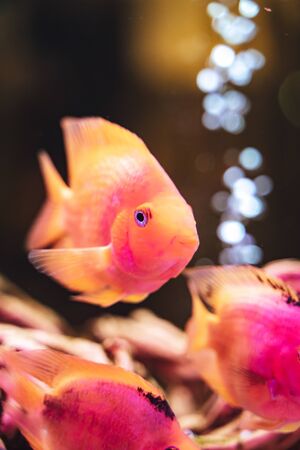Introduction to Fish Farming
Namaste! Welcome to the gentle world of fish farming, where water ripples with hope and families come together to create a sustainable future. Fish farming, also known as aquaculture, is the art and science of raising fish in controlled environments such as ponds, tanks, or rivers. In India, where rivers flow like lifelines and monsoons bless the land, fish farming has been an age-old tradition cherished by many communities.
For children and families in India, learning about fish farming is more than just understanding how fish grow; it’s about connecting with nature, respecting our water resources, and discovering how our everyday choices support our family’s well-being. Fish farming plays a vital role in Indian society by providing nutritious food, supporting rural livelihoods, and encouraging sustainable practices that protect Mother Earth for generations to come.
Through this gentle guide, we invite you—dear parents, little ones, and curious learners—to explore the basics of fish farming. Together, let us discover how this beautiful practice not only fills our plates with healthy meals but also brings communities closer and helps build a future where people and nature thrive side by side.
Types of Fish Commonly Farmed in India
In the heart of many Indian homes, fish is more than just food—its a celebration of flavors and traditions, woven into daily meals and festive gatherings alike. As we gently paddle through the world of fish farming education for kids and families in India, lets take a closer look at some of the most beloved fish species cultivated across the country. Understanding these popular varieties will help young learners and their families appreciate how these gentle swimmers play a role not only in our plates but also in our culture.
Popular Fish Species in Indian Aquaculture
India’s rivers, lakes, and ponds are home to several species that flourish under the care of local fish farmers. Among these, three names shimmer with special significance: Rohu, Catla, and Tilapia. Each brings its own story, flavor, and cultural importance.
| Fish Species | Local Name | Role in Indian Cuisine | Cultural Significance |
|---|---|---|---|
| Rohu | Rohu (रोहू/रोइ) | Main ingredient in Bengali fish curry, Andhra chepala pulusu | Served during festivals and family occasions; symbol of prosperity in Eastern India |
| Catla | Katla (कातला/কাতলা) | Popular in Bengali and Odia kitchens; used in fried or gravy dishes | Often gifted in weddings; featured during Durga Puja feasts |
| Tilapia | Korameenu (కొరమెను), Jalebi Machli (जलेबी मछली) | Loved for mild taste; cooked whole or as fillets across South India | A rising star for modern family meals and community picnics |
The Joys of Learning About These Fishes
For children growing up amidst mango trees and monsoon rains, learning about Rohu, Catla, and Tilapia can be a delightful way to connect with their roots. Whether it is watching elders prepare a spicy macher jhol or seeing colorful tilapias swim in a village pond, each moment is an invitation to understand not just the science but also the stories that make these fishes dear to Indian hearts.
Bringing Families Together Through Fish Farming Education
If you’re considering starting a small home pond or simply want your little ones to know where their favourite machli comes from, exploring these species can spark curiosity and pride. And who knows? Maybe someday your child will share with friends how Catla graced their family table during Diwali or how Tilapia was enjoyed on a lazy Sunday afternoon—making memories that last much longer than the meal itself.
![]()
3. Setting Up a Family-Friendly Fish Pond
Creating a fish pond at home or in your community is a wonderful way to bring the family together and teach children about aquatic life, responsibility, and the beauty of Indian biodiversity. Let us walk you through some easy, step-by-step tips for designing a small-scale, safe fish pond that every member of your family—even the little ones—can enjoy and help care for.
Step 1: Choose the Right Location
Select a spot in your backyard or terrace that gets partial sunlight. In Indian homes, a corner near the garden or even on an open balcony can work well. Make sure it is away from direct traffic and not under large trees that may drop leaves into the water. Safety first: ensure there is no risk of children accidentally falling in.
Step 2: Decide on the Pond Size and Shape
A pond as small as 3 feet by 4 feet can be perfect for families. Opt for round or oval shapes, which are easier to maintain. For apartments, consider portable tanks or containers available in local markets—just ensure they are made from non-toxic material and have smooth edges.
Step 3: Build with Local Materials
Use locally sourced stones, bricks, and waterproof liners (like tarpaulin) to create your pond structure. This makes your project cost-effective and eco-friendly! Involve children by letting them help arrange stones or paint small clay pots for decoration—Indian motifs add a special touch.
Step 4: Install Safety Features
Add a low fence or mesh netting around the pond if you have very young kids at home. You can also place sturdy stepping stones around the edge to prevent accidental slips. Teach children never to approach the pond alone; always have an adult present during feeding time or cleaning activities.
Step 5: Add Water & Prepare for Fish
Fill your pond with clean water—rainwater harvesting is an excellent sustainable option used widely in India! Let the water sit for a few days so any chlorine can dissipate. Next, introduce aquatic plants like lotus (kamal), water hyacinth, or duckweed, which help keep the water healthy and offer shelter to fish.
Involving Kids at Every Step
Invite your little ones to name the fishes, decorate the pond area with rangoli or diyas during festivals, and keep a simple notebook to record their daily observations. This way, learning becomes fun and connects your family with both nature and culture.
A Purr-fect Bonding Experience
Setting up a fish pond together nurtures patience, curiosity, and teamwork—qualities that blossom in young minds. Like caring for our furry feline friends, tending to fish creates gentle hearts and lifelong memories within Indian families.
4. Daily Care and Feeding Practices
In the heart of every Indian home, daily routines are cherished—whether it’s serving garam chai or feeding the family cat with a gentle hand. Fish farming, too, brings these soft rituals into our lives, especially when shared with curious children and loving families. Teaching kids about daily care and feeding practices for fish helps them develop responsibility and compassion, two qualities treasured in Indian culture.
Gentle Feeding Routines
Like how we patiently feed our street cats, feeding fish should be done with care. Overfeeding can harm both fish and water quality, while underfeeding leaves our finned friends hungry. Encourage children to feed the fish at the same time each day, using clean hands and measured amounts of food. Let them watch as the fish swim up eagerly—this small act builds a sense of connection and empathy.
| Feeding Time | Food Type | Portion Size |
|---|---|---|
| Morning (7-9 AM) | Puffed rice (murmura) or commercial pellets | A pinch per fish |
| Evening (5-7 PM) | Chopped spinach or boiled peas (occasionally) | Small handful for all fish |
Maintaining Water Quality
Just like we make sure our pets have clean bowls, our aquatic friends need fresh water to stay healthy. In India’s warm climate, water can get dirty quickly. Teach children to check the waters clarity and temperature daily. Once a week, help them change one-third of the tank or pond water. Explain that this simple routine prevents disease and keeps the fishes’ world sparkling clean—like a well-kept rangoli before a festival.
Observing Fish Health
Cats purr or hide when they feel unwell; fishes show us signs too. Encourage kids to observe if any fish are moving slowly, losing color, or have marks on their bodies. These gentle moments of watching help children become attentive and caring—skills that go beyond the pond into everyday life.
Simple Health Check Table
| Observation | What It Means | Action Needed |
|---|---|---|
| Lively swimming & eating well | Healthy fish | No action needed, just enjoy! |
| Lethargic or hiding often | Possible illness or poor water quality | Check water; consult adult or expert if needed |
| White spots/marks on body | Disease (e.g., Ich) | Isolate & treat; seek advice from local pet shop or expert |
A Gentle Lesson in Responsibility
Tending to fish together is much like nurturing any family member—gentle hands, patient eyes, and warm hearts make all the difference. These daily practices help Indian kids grow into compassionate caretakers, not just for animals but for everyone around them.
5. Traditional Wisdom and Modern Techniques
In the heart of every Indian village, stories flow as gently as rivers, carrying with them the wisdom of elders who have nurtured ponds and lakes for generations. Fish farming in India is not just a livelihood—it’s a tradition filled with respect for water, nature, and community. Grandparents often share age-old tips: choosing the right spot under the shade of neem trees, using cow dung to enrich pond soil naturally, or releasing fish fry during auspicious festivals like Makar Sankranti. These rituals are as comforting as a cat’s purr on your lap, reminding us that harmony with nature brings abundance.
Today, families are blending this traditional knowledge with simple modern techniques to make fish farming more efficient and enjoyable for everyone—including curious kids eager to help. With mobile phones in hand, children can now learn to check water quality using easy test kits or watch friendly videos in Hinglish about feeding schedules and fish health. Families use locally available feeds mixed with household scraps—rice bran, kitchen leftovers—reducing waste and keeping costs low.
Workshops led by local NGOs or Krishi Vigyan Kendras (KVKs) introduce families to improved practices such as constructing low-cost biofilters using coconut husk or introducing fast-growing native species like Rohu and Catla alongside traditional ones. These sessions often feel like playful kitten gatherings—full of questions, laughter, and sharing snacks under banyan trees.
By weaving together the gentle paw-steps of ancestral wisdom and the curious leaps of modern learning, Indian families create a nurturing environment for fish and children alike. The result? A sustainable fish farm that grows not only healthy fish but also bonds between generations—just like a family of cats curled up together after a day’s adventure.
Role of Fish Farming in Indian Family Life
In the heart of India’s villages and towns, fish farming is more than just a source of food—it is a beautiful thread that weaves families together. Picture a family in West Bengal, where grandparents tell stories of their childhoods spent beside the pond, teaching little ones to gently feed the fingerlings. This shared experience creates lasting memories and strengthens bonds across generations.
Fish farming also plays a vital role at the dining table. In Kerala, for example, home-reared karimeen (pearl spot) is often served during Onam celebrations, bringing an authentic taste of tradition to the family feast. In Assam, families prepare tangy fish curries with homegrown ingredients, connecting every meal to their roots and local waters.
The act of caring for the fish—feeding them every morning or cleaning the pond together—becomes a daily ritual that fosters teamwork and responsibility among siblings and cousins. Parents often say that their children learn patience and empathy by watching over the tiny lives in their backyard tanks or village ponds.
Moreover, fish farming supports local diets by providing fresh and nutritious protein. In many coastal communities, like those along Andhra Pradesh’s Godavari River, families rely on their own catch for meals, reducing dependence on markets and ensuring everyone eats well—even the family cat might sneak a taste!
Each region brings its own flavour to this tradition. Whether it’s spicy machher jhol in Bengal, meen pollichathu wrapped in banana leaf in Kerala, or simple fried rohu in Odisha, fish farming is deeply entwined with India’s diverse culinary heritage. Through these cherished recipes and shared experiences, families celebrate both unity and diversity at mealtimes.
Ultimately, fish farming isn’t just about raising fish—it’s about nurturing relationships, passing down wisdom from elders to children, and creating a sense of belonging that ripples through Indian family life like gentle waves across a beloved pond.
7. Community Events & Celebrations
Across India, fish farming is more than just a way to raise food—it’s a celebration of community and tradition. Families and children become active participants in vibrant local events that turn fish farming into an engaging and memorable experience. One of the highlights in many regions is the joyful fish harvest festival, where villagers come together to celebrate their hard work and share the bounty of their ponds. Kids love joining these festivals, learning traditional songs, dancing, and even helping with the harvest under gentle guidance from elders. Visiting bustling local fish markets is another enchanting activity for families. Here, children can witness the variety of fresh fish, observe lively bargaining in regional languages, and learn about different aquatic species straight from friendly vendors. These markets often turn into mini-carnivals with food stalls, games, and cultural performances—making every visit an adventure for young minds. Family-friendly workshops and community pond visits are also popular ways to introduce children to fish farming techniques in a hands-on manner. Local NGOs and schools sometimes organize “Fish Farming Days,” complete with storytelling sessions about legendary river fish or eco-friendly fishing practices. Such events weave together education, fun, and togetherness—creating memories as heartwarming as a kitten curled up on your lap. Through these celebrations and shared experiences, Indian kids and families not only gain practical knowledge but also develop a deep respect for nature’s gifts and the rich traditions that make fish farming a cherished part of their lives.


